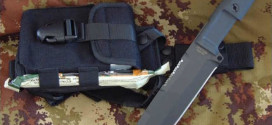For protection, safety and security, a knife sheath is required. The basic requirements of this attribute are durability, convenience and reliability. At the first stage, the material of manufacture is selected, from which the sheath for the knife will be made with your own hands. It should not change its properties under the influence of moisture and temperatures, have a rigid base to protect the blade.
Content
Do-it-yourself knife sheaths: where to start?
First you need to decide on the design. It is recommended to use the standard configuration - it will be difficult for a beginner to make a sheath with additional compartments and sections. Then choose the material of manufacture - leather, wood, dense fabric. It is not recommended to make a plastic construction - there is a possibility of a burr on the inside, which will lead to constant scratching of the blade.
Manufacturing steps:
- Sample. A thick sheet of paper is folded in half, a knife is placed on it. We outline the contours, taking into account the seam allowance from the side of the sharp edge. For a leather knife sheath, this is approximately 10 mm. It is better to make the mount separately so that it is possible to dismantle it and install another.
- blank. The source material is cut according to the template, allowances for the connection are taken into account. Wooden sheaths are made without them, as the halves are often glued together with special glue. The entry of the blade is checked - it should not experience resistance, but at the same time, the play is minimal.
- Insert. It is located on the inside, from the side of the sharpened blade. The recommended manufacturing material is soft wood or dense felt. This is necessary to maintain the sharpness of the blade. This is one of the additional features that a leather scabbard should have.
- Wearing method. The most common is hanging. On a wooden or leather scabbard, a loop is made at the top of the structure. It attaches to a belt. The horizontal arrangement is convenient for small blades. In addition to the upper loop, another one is made, at the other edge of the structure.
To protect against moisture, the surface of the material of manufacture can be treated with special compounds. It is important that they do not have a negative effect on steel - do not lead to its rusting, rapid wear of the blade.
Leather
The easiest way to make your own is a leather sheath. We recommend saddle leather or rawhide as material. They work well and hold their shape well. The seam connection ensures a snug fit at the edges. This can be done with an awl or with an overlocker.
For this type of scabbard, you will need the following materials and tools:
- Awl or overlock. If this is a single production, you can stop at the awl.
- Thread up to 0.7 mm thick. It is treated with paraffin for better gliding.
- Glue and thinner. The seam is treated with this composition so that the case for the folding knife has maximum tightness and reliability.
- Felt insert. An alternative is to install a plastic insert.
Stitched components are tested for strength, homemade scabbards should be comfortable. The knife is removed without effort, to fix it, you can install a small rubber insert on the inner surface, closer to the loop. She will press the blade, preventing the knife from falling out when walking.
In the video material you can find step-by-step instructions for self-production:
Wooden
How to make a wooden knife This design has better aesthetic qualities than a leather product. But in terms of performance, it is inferior to them. For the manufacture of a sheath for a knife from wood, hardwoods are taken - walnut, oak, beech. They are difficult to process, but the quality will be optimal.
Wooden sheaths are made according to the following scheme:
- The contour of the blade is cut out on two dies. Its dimensions should be 2-5 mm larger than the blade.
- The dies are cut off, the inner surface is processed with a chisel. The depth of processing is greater than the thickness of the blade by 1-2 mm. Then sanding with sandpaper and polishing.
- Connecting blanks and checking the entry of weapons.
- Bonding two pieces. For this, standard wood glues are used.
- External surface treatment.
Wooden scabbards are difficult to manufacture, but they can be beautifully customized by applying a pattern or pattern to the surface, treated with varnishes or paints. A leather loop is mounted on the belt for fastening.
You can also make a knife sheath out of fabric. But such homemade products will not last long, since additional processing will be required to improve their performance. This may affect the condition of the blade.
Hello, I am Alexander, the mastermind behind the blog.
In terms of career and free time, I connected my life with the forest. How else, when you live in Karelia! In this blog, I am responsible for the hunting, hiking and equipment sections. Welcome to my world!
 Survival Lessons Tips for the survivalist, fisherman and hunter
Survival Lessons Tips for the survivalist, fisherman and hunter





